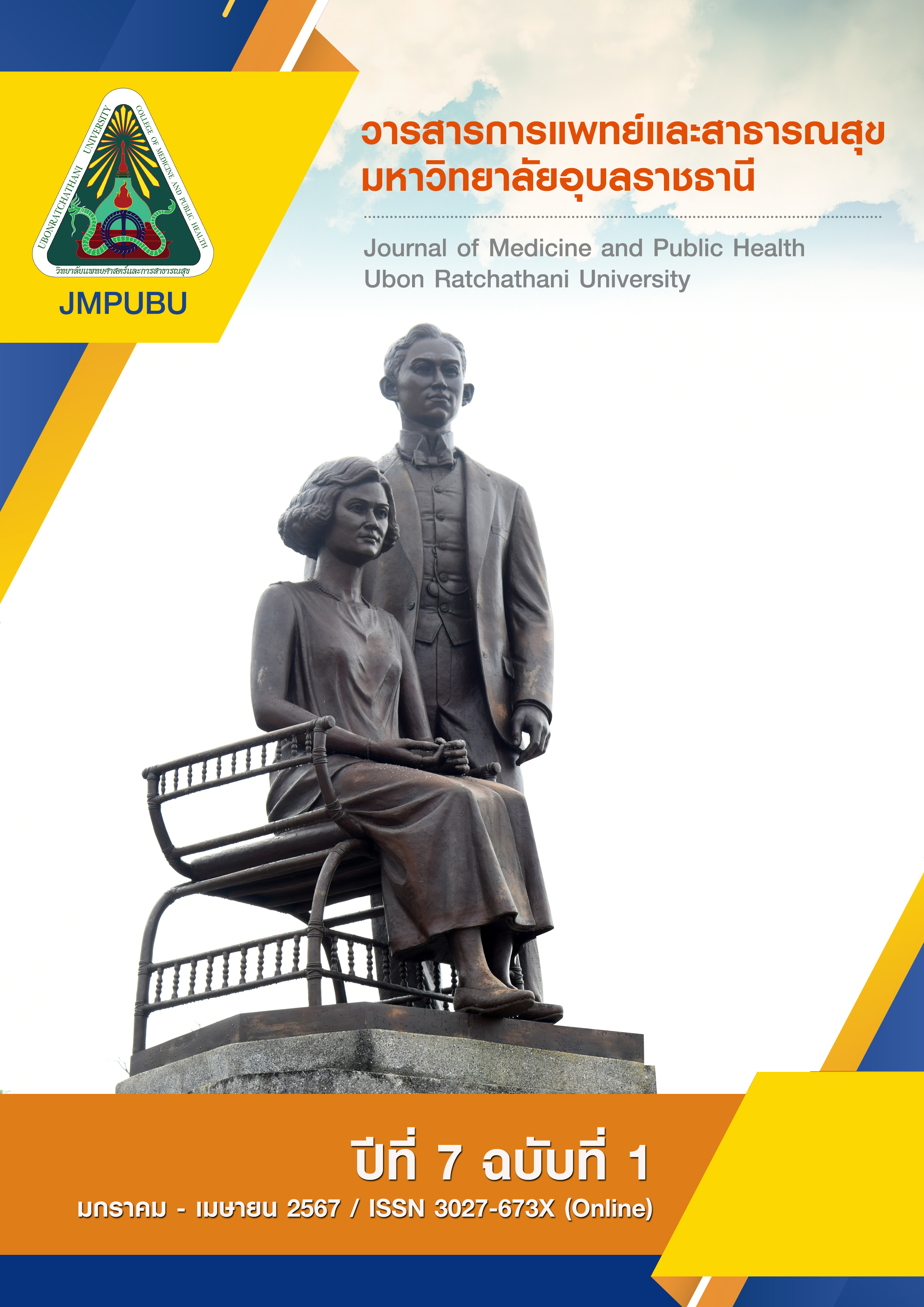การสูญเสียสมรรถภาพการได้ยินในกลุ่มช่างทอผ้า ปักธงชัย นครราชสีมา
คำสำคัญ:
การสัมผัสเสียงดัง , การสูญเสียสมรรถภาพการได้ยิน , ช่างทอผ้า , เสียงดังเป็นช่วงบทคัดย่อ
การศึกษาครั้งนี้มีวัตถุประสงค์เพื่อศึกษาระดับเสียงดัง สมรรถภาพการได้ยินของช่างทอผ้าไหม เปรียบเทียบระดับเสียงดังที่ช่างทอผ้าไหมใช้กี่ไม้และเหล็กได้รับ รวมทั้งหาความสัมพันธ์ของระดับเสียงดังที่ได้รับตลอดระยะเวลาการทำงานสูงสุด (Max) และระดับเสียงสูงสุด (Peak) กับระดับเสียงดังแบบแยกความถี่ ในโรงงานทอผ้าไหม 2 แห่ง อำเภอปักธงชัย จังหวัดนครราชสีมา กลุ่มตัวอย่างรวม 12 คน ซึ่งมีประสบการณ์ทำงานเฉลี่ย 20 ปีขึ้นไป ผลการศึกษา พบว่า ระดับเสียงดังที่ช่างทอผ้าไหมได้รับมีค่าเฉลี่ยตลอด 8 ชั่วโมง เท่ากับ 61.3±9.4 (กี่ไม้) และ 62.4±14.7 dBA (กี่เหล็ก) และมีค่าไม่เกินมาตรฐาน ผลการทดสอบทางสถิติเปรียบเทียบระดับเสียงดังที่ช่างทอผ้าได้รับจากกี่ทั้งสองไม่แตกต่างกันอย่างมีนัยสำคัญทางสถิติ (p-value = 0.976) โดยมีลักษณะเสียงดังสลับเบา เมื่อทดสอบความสัมพันธ์ระหว่างค่า Max, Peak กับระดับเสียงแบบแยกความถี่ของกี่ไม้และเหล็กในช่วง 500 – 2,000 Hz พบว่า มีความสัมพันธ์กันอย่างมีนัยสำคัญทางสถิติ จึงสามารถสรุปได้ว่า ระดับเสียงดังที่ช่างทอผ้าไหมได้รับเกิดจากความถี่ช่วง 500 – 2,000 Hz ทั้งนี้พบว่า ช่างทอผ้ามีความผิดปกติของการได้ยินในช่วงความถี่ดังกล่าวในระดับเล็กน้อย สูงถึงร้อยละ 50 ซึ่งอาจบ่งชี้ความผิดปกติของหูชั้นกลาง คอเคลีย โสตประสาท และก้านสมองได้ นอกจากนี้ระดับความรุนแรงของการสูญเสียการได้ยินในช่วง 500 – 6,000 Hz ของช่างทอผ้าไหมในหูข้างที่ดีกว่า มีการสูญเสียการได้ยิน (ร้อยละ 66.8) ตั้งแต่ระดับเล็กน้อยไปถึงรุนแรงมาก ดังนั้นมาตรการเฝ้าระวัง การตรวจการได้ยิน รวมทั้งการใส่ปลั๊กอุดหูยังคงจำเป็นอยู่
Downloads
เอกสารอ้างอิง
ศูนย์ข้อมูลและดิจิทัลอุตสาหกรรม (แผนกข้อมูลอุตสาหกรรม) สถาบันพัฒนาอุตสาหกรรมสิ่งทอ. สถานการณ์อุตสาหกรรมสิ่งทอและเครื่องนุ่งห่มไทย เดือนธันวาคม 2563 [อินเตอร์เน็ต]. [สืบค้นเมื่อ 18 เมษายน 2666]. แหล่งข้อมูล:
https://www.thaitextile.org/th/insign/detail.2292.1.0.html
กรมควบคุมโรค กระทรวงสาธารณสุข. รายงานสถานการณ์โรคและภัยสุขภาพจากการประกอบอาชีพและสิ่งแวดล้อม ปี 2560 [อินเตอร์เน็ต]. [สืบค้นเมื่อ 12 สิงหาคม 2566]. แหล่งข้อมูล:
https://ddc.moph.go.th/uploads/ckeditor2//files/01_envocc_situation_60.pdf
สำนักงานประกันสังคม กระทรวงแรงงาน. สถานการณ์การประสบอันตรายหรือเจ็บป่วยเนื่องจากการทำงาน ปี 2561 – 2565 [อินเตอร์เน็ต]. [สืบค้นเมื่อ 12 สิงหาคม 2566]. แหล่งข้อมูล:
https://www.sso.go.th/wpr/assets/upload/files_storage/sso_th/102220b2a37b7d0ea4eab82e6fab4741.pdf
Basu S, Aggarwal A, Dushyant K, Garg S. Occupational Noise Induced Hearing Loss in India: A Systematic Review and Meta-Analysis. Indian J Community Med. 2022; 47(2):166-171.
World Health Organisation. WHO programme for prevention of deafness and hearing loss: an outline [Internet]. [cited 2023 April 29].
ศูนย์พัฒนาวิชาการอนามัยและสิ่งแวดล้อม จังหวัดสมุทรปราการ กรมควบคุมโรค. แนวทางการเฝ้าระวัง ป้องกัน ภาวะสูญเสียการได้ยินจากเสียงดังจากการประกอบอาชีพ [อินเตอร์เน็ต]. {สืบค้นเมื่อ 14 ตุลาคม 2566}. แหล่งข้อมูล:
https://ddc.moph.go.th/uploads/publish/1030820200713105552.pdf
Palmer KT, Griffin MJ, Syddall HE, Davis A, Pannett B, Coggon D. Occupational exposure to noise and the attributable burden of hearing difficulties in Great Britain. Occup Environ Med. 2002; 59(9):634–639.
Azizi MH. Occupational noise–induced hearing loss. JOEM. 2010; 116-123.
Council on Scientific Affair. Noise-induced hearing loss. JOEM. 2003; 45(6):579-581.8.
Occupational Safety & Health Administration. 1910.95 - Occupational Noise Exposure [Internet]. [cited 2023 August 17]. Available from:https://www.osha.gov/laws-regs/regulations/standardnumber/1910/1910.95
Occupational Safety & Health Administration. 1910.95 App D - Audiometric Test Rooms [Internet]. [cited 2023 August 17]. Available from:https://www.osha.gov/laws-regs/regulations/standardnumber/1910/1910.95AppD
สำนักโรคจากการประกอบอาชีพและสิ่งแวดล้อม กรมควบคุมโรค. แนวทางการตรวจคัดกรองสมรรถภาพการได้ยินและการแปลผล (ฉบับปรับปรุง ปี 2560) [อินเตอร์เน็ต]. {สืบค้นเมื่อ 24 สิงหาคม 2566}.
แหล่งข้อมูล: https://ddc.moph.go.th/uploads/publish/1352020221125100616.pdf
Occupational Safety and Health Administration U.S. Department of Labor. OSHA Technical Manual (OTM) Section III: Chapter 5 [Internet]. [cited 2023 August 27]. Available from: https://www.osha.gov/otm/section-3-health-hazards/chapter-5#hearingloss
Mirza R, Kirchner DB, Dobie RA, Crawford J, ACOEM Task Force on Occupational Hearing Loss. Occupational noise-induced hearing loss. ACOEM. 2018; 60(9):e498-e501.
Berger EH, Royster LH, Royster JD, Driscoll DP, Layne M. In: The noise manual (revise). 5th edition. American Industrial Hygiene Association. 2003.
American Academy of Audiology. Noise-induced hearing loss [Internet]. [cited 2023 August 12]. Available from: https://www.audiology.org/consumers-and-patients/hearing-and-balance/noise-induced-hearing-loss/
Setyawan FEB. Prevention of noise induced hearing loss in worker: a literature review. JKKI. 2021; 12(2):182-190
Salmon MK, Brant J, Hohman MH, Leibowitz D. Audiogram Interpretation [Internet]. [cited 2023 June 9]. Available from: http://www.ncbi.nlm.nih.gov/books/NBK578179/
The national hearing test. How to read an audiogram and determine degrees of hearing loss [Internet]. [cited 2023 September 6]. Available from: https://www.nationalhearingtest.org/wordpress/?p=786
Nandi SS, Dhatrak SV. Occupational noise-induced hearing loss in India. Indian J. Occup. Environ. Med. 2008; 12(2):53-6.
Sheikh I, Ali I, Makhdoomi O, Wani RT. Occupational noise induced hearing loss among local industrial population in Kashmir: a lifestyle study. Int J Otorhinolaryngol Head Neck Surg. 2018; 4(4):1023.
Rabinowitz PM. Noise-induced hearing loss. Am Fam Physician. 2000; 61(9):2749-56, 2759-60.
Zhang Y, Liu Y, Li Z, Liu X, Chen Q, Qin J, et al. Effects of coexposure to noise and mixture of toluene, ethylbenzene, xylene, and stylene (TEXS) on hearing loss in petrochemical workers of southern China. Environ Sci Pollut Res Int. 2023; 30(11):31620-31630.
ดาวน์โหลด
เผยแพร่แล้ว
รูปแบบการอ้างอิง
ฉบับ
ประเภทบทความ
สัญญาอนุญาต
ลิขสิทธิ์ (c) 2023 วารสารการแพทย์และสาธารณสุข มหาวิทยาลัยอุบลราชธานี

อนุญาตภายใต้เงื่อนไข Creative Commons Attribution-NonCommercial-NoDerivatives 4.0 International License.
เนื้อหาและข้อมูลในบทความที่ลงตีพิมพ์ในวารสารการแพทย์และสาธารณสุข มหาวิทยาลัยอุบลราชธานี ถือเป็นข้อคิดเห็นและความรับผิดชอบของผู้เขียนบทความโดยตรง ซึ่งกองบรรณาธิการวารสารไม่จำเป็นต้องเห็นด้วย หรือร่วมรับผิดชอบใด ๆ
บทความ ข้อมูล เนื้อหา รูปภาพ ฯลฯ ที่ได้รับการตีพิมพ์ในวารสารการแพทย์และสาธารณสุข มหาวิทยาลัยอุบลราชธานี ถือเป็นลิขสิทธิ์ของวารสารการแพทย์และสาธารณสุข มหาวิทยาลัยอุบลราชธานี กองบรรณาธิการไม่สงวนสิทธิ์ในการคัดลอกเพื่อการพัฒนางานด้านวิชาการ แต่ต้องได้รับการอ้างอิงที่ถูกต้องเหมาะสม






